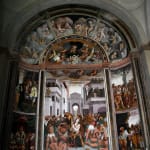Italian School, 17th century
30 x 19 cm
Further images
Provenance
Private collection, France
Private collection, Germany
Executed in red chalk, this animated sheet presents a scene of courtly or biblical character, with a richly dressed elder seated on a throne and a female figure presenting an object—perhaps a ring or a jewel—surrounded by secondary figures and two playful putti at the foreground. The elegant, linear handling and compositional structure relate closely to the fresco cycle by Bernardino Lanino (c. 1512–1582) in the church of Santa Caterina in Milan.
While the drawing was formerly attributed to Agostino Ciampelli (1565–1630), both the technique and the subject matter suggest it may instead be the work of a later hand copying or interpreting Lanino’s work, possibly within a Lombard or Florentine context. The inscription “Vani” on the verso has led some to suggest a connection with Ottavio Vannini (1585–1643), though this attribution remains tentative.
Join our mailing list
Join our mailing list to stay informed about our latest discoveries and upcoming exhibitions (once a month).
* denotes required fields
We will process the personal data you have supplied in accordance with our privacy policy (available on request). You can unsubscribe or change your preferences at any time by clicking the link in our emails.





